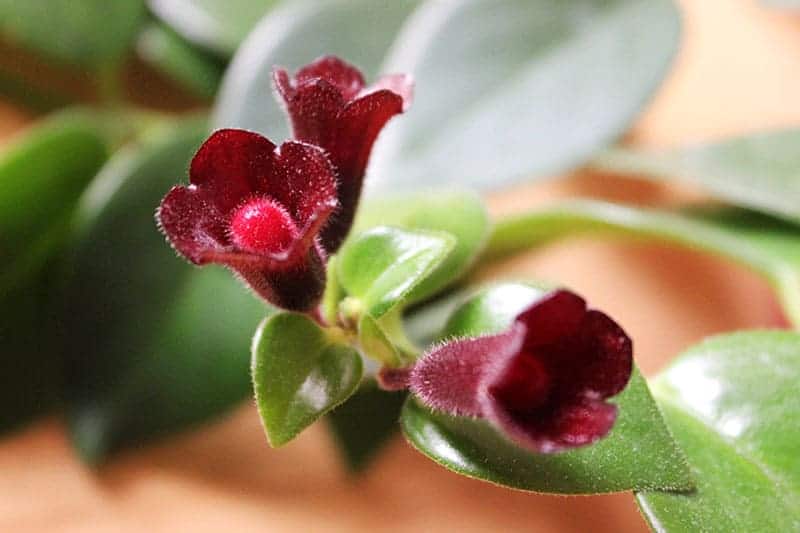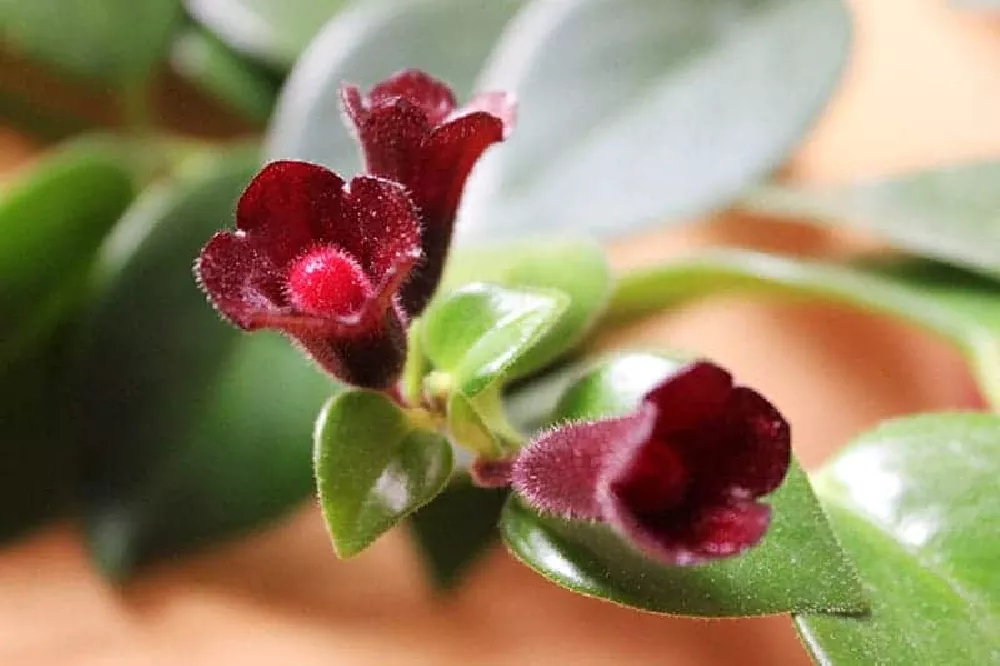- Home >
- Houseplants >
- Lipstick Plants
Lipstick Plants for Sale - Buying & Growing Guide
Enter your zip code to find nearby stores that may carry this plant.
Plant Care
Sunlight

Avoid full sunlight and full shade. Bright indirect or filtered light is ideal.
Watering
Keep soil consistently moist. Water when the surface becomes dry.
Fertilizing

Fertilize regularly, about once every week or every other week during the growing season.
The eye-catching Aeschynanthus radicans is famous for its unique blooms. One look will tell you how this plant got its name: each colorful flower grows from a darker sleeve, giving it the appearance of a tube of lipstick. Native to tropical Malaysia, the lipstick plant is also called lipstick vine. Indoor lipstick plants bloom year-round when given a warm spot with indirect sunlight. A small-size container will encourage more flowers. Here are some other quick facts about lipstick plants:
- Plant in a small pot to encourage the growth of new flowers
- Blooms all year long with good care
- Needs plenty of bright, indirect sunlight in order to thrive
Planting and Care
Planting instructions
Lipstick plants do best in hanging baskets or shelf containers. If placing your lipstick vine on a surface, make sure to leave room for vines to grow outward. Pot your lipstick plant in a small container, with just enough soil to surround the roots. Choose an airy, fast-draining soil. Adding a bit of sphagnum moss helps maintain moisture around the roots without over-soaking the plant. You can also include perlite for better drainage. Keep your heat-loving tropical plant in a location that maintains a room temperature of at least 70 degrees Fahrenheit. Also, the planting location should not have too much sun or shade. Filtered light is best in outdoor settings, while moderate amounts of bright indirect light are ideal indoors.
Watering and nutrients
Lipstick plants thrive in medium humidity. Be careful not to overwater, as this species is prone to root rot. Water once the surface of the soil feels dry. If the leaves begin to shrivel, your plant needs more water. If leaves fall off, you’re watering too often. Choose a 3-1-2 fertilizer mixture and dilute to one-half strength. Feed every other week in spring and summer and once a month during fall and winter.
Pruning
A lipstick plant produces vines regularly due to its climbing nature. Cutting your lipstick plant back when vines get too long gives it a healthier look and stimulates the growth of new blossoms. Wait until all buds on the plant have bloomed before you begin pruning. Using small pruners or sharp kitchen shears, cut vines just above the leaf node. It’s best to stick to removing a third or less of this plant, which tends to get long and thin. Pruning can help contain its spread and give it a neater, more shrub-like appearance.
Pests and diseases
Pests aren’t usually a problem when it comes to the lipstick plant, as it’s generally grown indoors. However, spider mites are attracted to lipstick plants and can damage leaves in a very short period of time. If you notice these pests, mix one teaspoon of mild dish soap in one liter of water and lightly spray the leaves. In order to stem off fungal disease, use a well-draining, airy soil and be careful not to overwater. You should always wipe pruner blades with rubbing alcohol and allow them to dry completely before cutting vines so that you do not introduce bacteria into the plant.
Light
This plant needs bright, indirect light. It should not be placed in a position of full sun as this will scorch the leaves, but if it does not get enough light, it will struggle to have the energy to produce flowers. Aim for around six hours of indirect light each day.
Temperature
As a subtropical plant in its native environment, the lipstick plant likes to be kept warm. Ideally, it should be in a temperature range of 70-85° F. At around 65° F. the plant will survive, but it will not thrive, and you will see this from the lack of flowers it produces at this temperature. If the plant is subjected to temperatures of 50° F or lower, then it will likely suffer, and as a result of this, all of the bright green foliage will turn a dull shade of red.
It is easy to keep the lipstick plant happy as a houseplant as it is comfortable in temperatures the same as people typically like to have their homes. Remember to keep your plant in a room that is heated throughout the winter, but away from any vents which may dry it out. As the plant can suffer injury in low temperatures, it is best to keep it in a position protected from cold drafts, ideally away from open windows or entryways (University of Florida).
Humidity
The lipstick plant enjoys high humidity, as it would be subject to in its natural environment in the tropics. It usually does just fine in regular household humidity, so this isn’t a care element you need to worry too much about, but the plant will benefit from an occasional water misting spray if you happen to be spraying other humidity loving plants at the same time. Most people keep this vine in hanging baskets, which means that pebble trays are not a practical option, but if you wish to increase humidity in other ways, you can group plants together or use a humidifier.
Propagation
The lipstick plant can be easily propagated with stem cuttings. Choose a stem of new growth and cut it at around four inches in length. Make sure that the stem is not flowering and does not have any buds on it. Dip the cut end of the stem into rooting hormone, and then plant it in a moist growing medium in a small pot. Keep it in a warm position away from direct sunlight, and wait for the stem to root.
To increase the speed of rooting and chances of success, create a mini greenhouse environment by putting a clear plastic bag over your cutting and pot, which will create humidity. After four to six weeks, the stem should have rooted. You can check for this by noting new growth or gently tugging at the stem to see if it easily slides out of the soil. If it holds onto the soil, then it has rooted. Wait a further few more weeks for the roots to gain strength, and then transplant the cutting to a larger pot and offer it regular care conditions.
Flowering
The lipstick plant is able to bloom most of the year-round but will bloom most prolifically in late summer and fall. If you’re looking for an easy-to-care flowering houseplant to bring some color into your home during the winter months, then this would be a great option. The flowers resemble lipstick as they bloom, with the small orange or red flower growing out of a cylindrical shaped bud (Royal Horticultural Society).
Lipstick Plant Varieties
Around 150 species of Aeschynanthus exist. Some of the most popular varieties include the following.
Aeschynanthus radicans ‘Mona Lisa’

This variety of lipstick plant is a prolific bloomer, so if you want the best chances of a plant that blooms in abundance all year round, then this could be the one for you. Its flowers are a bright red.
Aeschynanthus radicans ‘Variegata’
This lipstick plant has intense red flowers set against green foliage with a creamy variegation.
Aeschynanthus ‘Cassiopeia’
The flowers of this variety emerge from dark purple buds, giving it a theatrical air.
Aeschynanthus radicans ‘Curly’
This is an especially unusual-looking variety of lipstick plant, grown for its vines which curl around in a whimsical manner. The leaves on this twirling vine are dark green.
Aeschynanthus ‘Purple Star’
The flowers of this plant are red with splashes of purple.
Aeschynanthus radicans ‘Rasta’
The leaves of this lipstick plant twist in on themselves, giving the vines a very chunky and full look when admired from a distance.
Aeschynanthus radicans ‘Tangerine’
This variety of lipstick plant features flowers in an orange-yellow color.
Aeschynanthus radicans ‘Krakau’
The leaves of this plant are especially shiny, and the flowers are red.
Aeschynanthus longicaulis ‘Black Pagoda’
The flowers on this lipstick plant are less remarkable than its relatives, as they are small and green. This plant is more commonly grown for its foliage, which has a mottled effect in mid and paler shades of green.
FAQs
What are other names for the lipstick plant?
How do you propagate lipstick plants?
Lipstick plants grow well from cuttings, or you can grow them from their seeds. For the cuttings, take a two-inch piece from the tip of a non-flowering vine and root it in a mix of peat moss and perlite. Make sure the soil stays damp but not soaked. To grow new plants from seed, barely cover them with soil and keep the pots in a shaded area until the shoots poke through the soil. Keep the room warm. Shoots should break through the soil in about 10 to 12 days.
How large do lipstick plants grow?
In the rainforest, a naturally-growing lipstick plant will continue to vine as long as it’s healthy. As a potted or shelf plant, you can grow your lipstick vine up to two to three feet. Most growers prefer to keep the vines fairly short, opting for a fuller, compact flowering plant.
What if my lipstick plant won’t grow flowers?
Make sure your lipstick plant is receiving the right amount of light each day. Place it near but not directly in bright sunlight, as too much sun can burn the foliage. And double-check that your lipstick plant is receiving the right nutrients — it needs to be fed on a regular schedule in order to keep producing flowers. Also be sure to prune your plant regularly, as this will stimulate the growth of new buds.










